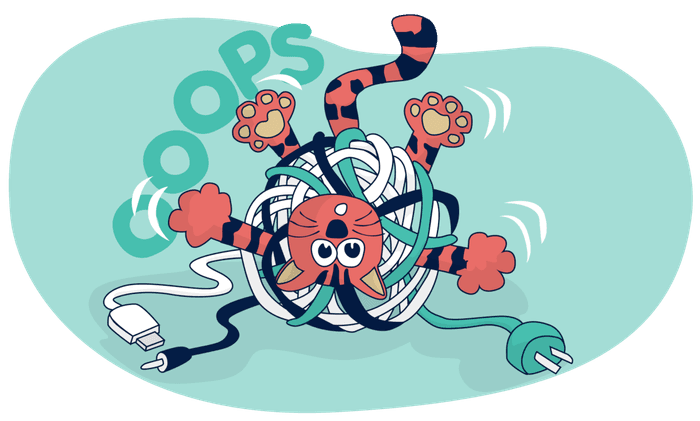The ABC inventory classification method
Effective inventory management is all about prioritization.
Essentially, there’s no good reason to give every product equal attention when the value that one product delivers can be very different from that of another product.
That’s where the ABC analysis method comes in. This method categorizes inventory items based on their importance and value, allowing you to focus your resources where they matter most.
What is ABC inventory analysis?
The ABC inventory classification method is a way of categorizing inventory items based on their importance.
- Class A: 20% of items that drive 80% of inventory-based revenue. Require tight controls. Count monthly.
- Class B: 30% of items that drive 15% of inventory-based revenue. Require moderate controls. Count quarterly.
- Class C: 50% of items that drive 5% of inventory-based revenue. Require liberal controls. Count annually.
It’s important to note that there are no fixed thresholds for each class and different ratios can be applied depending on inventory composition and business objectives.
Class A items
Class A items are your top performers. They represent about 20% of your inventory but generate about 80% of your inventory revenue. These items require tight control, accurate records, and should never be out of stock. Because these items have a significant impact on the finances of your practice, they should be counted most frequently.
Common examples of A items:
- Specialty drugs.
- Vaccines.
- Flea and deworming products.
- NSAIDs.
Class B items
Class B items are the next 30% of your most valuable inventory items and account for 15% of inventory revenue. They might not be the most valuable products, but they’re still critical for your daily work. These items require moderate control and should be counted less frequently than Class A items, but more frequently than Class C items.
Common examples of Class B items:
- Prescription diets.
- Chronic medication.
Class C items
Class C items are your lowest-value items and your lowest priority. They make up 50% of your inventory but only a small percentage of the value of your inventory (typically around 5-10%). These products tend to be useful for day-to-day work, but don’t individually contribute significant value to the business. They require the least stringent controls and the least amount of your time.
Common examples of Class C items:
- Blood transfusion sets.
- Urine sampling kits.
- Cotton balls.
- Gauze.
How to classify items
To categorize your inventory into A, B, and C classes, you’ll need to run an inventory sales report in your practice management software. The report should cover sales for at least the last 12 months, which will account for any seasonal variations. Export the report as a CSV, which will make it easier to sort and filter through the data.
Color code products according to their classification
To easily identify your ABC classes, consider physically color coding your inventory using stickers, labels, and/or tags. How you color code them is up to you, but we suggest making Class A the most striking color, and Class C the least striking.
For example:
- Class A: Red.
- Class B: Yellow.
- Class C: Green.
Using clear visual cues to organize your inventory can go a long way toward helping staff quickly locate and prioritize the most critical items.
Takeaway
Implementing the ABC classification method can lead to significant improvements in inventory control and overall operational performance. By focusing on what matters most, you can ensure your practice is well-equipped to meet the needs of your patients while maintaining a healthy bottom line.
What’s the ideal inventory turnover rate for veterinary practices?
Inventory is not an investment. Investments gain value over time. Inventory does not. For every minute that a product sits on the shelf, it’s actually costing you money (in storage costs, labor, shrinkage, spoilage-related lost revenue, etc. - more on this here).
What inventory is, is a means of making money by using or selling a product. Therefore, the key to maximizing inventory profitability is ensuring that you’re regularly turning over inventory through consistent product sales.
What should your inventory turnover rate be?
An ideal inventory turnover rate for veterinary practices is between 8 and 12 times per year. This means that, on average, products should not remain on your shelves for more than 30 to 45 days. This turnover rate ensures that your stock is moving efficiently, and helps reduce the risks associated with expired products and overstocking.
It’s important to recognize that this average is a composite of all products within your inventory. Your A Class products will naturally have more turns compared to your B and C Class products. So, it’s essential to monitor the turnover rate of individual products closely. It’s highly likely that your inventory will include some slow-moving items that aren’t available in smaller quantities but are absolutely essential to keep in stock.
Setting reorder points
Identifying your optimal turnover rate allows you to determine your inventory reorder points.
A reorder point is exactly what it sounds like: The threshold at which you should order new inventory to maintain optimal stock levels. It’s a proactive approach to inventory management that ensures you have sufficient stock for the future based on past usage trends. Some practice management systems can be configured to automatically order inventory when stock reaches a user-specified reorder point.
To determine your reorder points, you’ll need to review past usage data by running an appropriate inventory report in your practice management software. Note that order points should be based on previous usage, not previous purchases.
For example, if your goal is to achieve 12 inventory turns per year (essentially a monthly supply), you can review the past year's data of a given product and divide it by 12. This calculation will give you a baseline for reorder points and/or reorder quantities.
If you prefer a lower reorder point or lower reorder quantity, you can divide the past usage data by a higher turnover rate, such as 18-26 times per year, which corresponds to a two- to three-week supply.
It’s important to note that smaller hospitals with high turnover rates may not have the physical space to store large amounts of inventory. In such cases, adjusting your reorder points and quantities is essential. For instance, instead of placing a monthly order for consumables, you might place a fortnightly order to align with your storage capacity.
Margin vs markup
When it comes to setting product prices, remember that margin and markup are two very different things - and getting them mixed up can have a major impact on profitability.
Markup
Markup refers to how much you increase the cost of a product to determine its selling price. It’s calculated as a percentage of the cost. Let’s say Product X costs $10, and you sell it for $12.50.
To calculate the markup percentage:
($12.50 – $10) ÷ $10 = 0.25 or 25% markup
This means you marked up the cost by 25% to reach your selling price.
Margin
Margin, on the other hand, represents the percentage of the selling price that is actual profit. To calculate the profit margin on the same product above that you bought for $10 and sold for $12.50:
($12.50 – $10) ÷ $12.50 = 0.20 or 20% margin
Why it matters
If a practice confuses markup and margin, they may undercharge for products, reducing profitability. For instance, if you aim for a 50% margin but mistakenly apply a 50% markup, you’ll end up with less profit than expected. Over time, these miscalculations can significantly affect your practice’s bottom line.
Pricing is an art, not a science
It’s important to realize that setting a selling price involves more than just marking up the initial cost. The true COGS includes not only the purchase price but also the time your team spends ordering, stocking, and managing the product.
Consider what the market will bear. While applying a flat markup across all products is an easy way to get started, it’s usually not the best option to maximize profitability in the long run. Instead, look at value-based pricing, a strategy that involves pricing products and services based on the perceived value to the client rather than just the cost of delivery. For example, high-volume, low-cost items may require a smaller markup, while specialized or in-demand products might justify a higher price.
Factoring in both market demand and client value can help you price more strategically and increase profitability.
Ordering frequency: Bulk vs just-in-time-ordering
When it comes to ordering inventory, balance is key.
Bulk buying
Buying inventory in bulk may seem appealing, especially with the potential for discounts. However, purchasing more than three months’ worth of stock at once is often not profitable unless there are substantial savings and the risk of expiration is minimal. In cases where holding costs are high, turnover is low, and shrinkage risk is high, it might make more financial sense to use a pharmacy rather than spend resources on keeping the product in stock yourself.
Just-in-time ordering
At the other end of the spectrum, an increasing number of practices are using just-in-time (JIT) ordering, a strategy that involves receiving goods as close as possible to when they are needed. While the JIT approach can be a savvy way to keep your holding costs low, it usually results in higher labor costs. Employees need to process a higher number of smaller orders, with inventory arriving multiple times per week (or even per day!). There’s also a higher risk of stockouts and backorders. For this reason, JIT ordering is often best reserved for your B and C Class products.
Tailor ordering to your needs
Tailor your inventory management practices to your hospital's specific needs and constraints. While the recommended guidelines provide a solid foundation, don’t hesitate to modify them to suit your practice's size, storage capacity, and operational rhythms.




